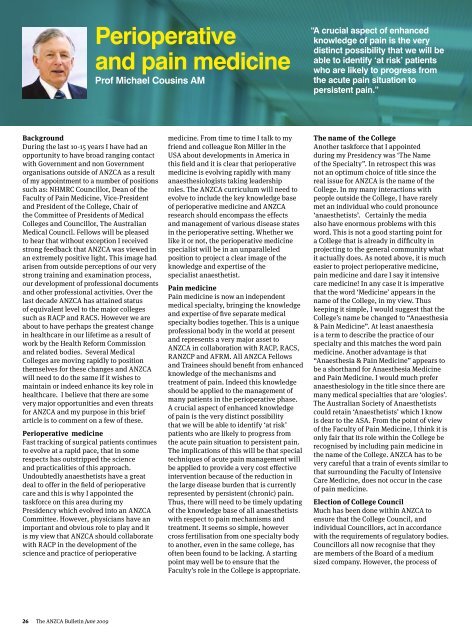ANZCA Bulletin - June 2009 - Australian and New Zealand College ...
ANZCA Bulletin - June 2009 - Australian and New Zealand College ...
ANZCA Bulletin - June 2009 - Australian and New Zealand College ...
- No tags were found...
Create successful ePaper yourself
Turn your PDF publications into a flip-book with our unique Google optimized e-Paper software.
Perioperative<strong>and</strong> pain medicineProf Michael Cousins AM“A crucial aspect of enhancedknowledge of pain is the verydistinct possibility that we will beable to identify ‘at risk’ patientswho are likely to progress fromthe acute pain situation topersistent pain.”BackgroundDuring the last 10-15 years I have had anopportunity to have broad ranging contactwith Government <strong>and</strong> non Governmentorganisations outside of <strong>ANZCA</strong> as a resultof my appointment to a number of positionssuch as: NHMRC Councillor, Dean of theFaculty of Pain Medicine, Vice-President<strong>and</strong> President of the <strong>College</strong>, Chair ofthe Committee of Presidents of Medical<strong>College</strong>s <strong>and</strong> Councillor, The <strong>Australian</strong>Medical Council. Fellows will be pleasedto hear that without exception I receivedstrong feedback that <strong>ANZCA</strong> was viewed inan extremely positive light. This image hadarisen from outside perceptions of our verystrong training <strong>and</strong> examination process,our development of professional documents<strong>and</strong> other professional activities. Over thelast decade <strong>ANZCA</strong> has attained statusof equivalent level to the major collegessuch as RACP <strong>and</strong> RACS. However we areabout to have perhaps the greatest changein healthcare in our lifetime as a result ofwork by the Health Reform Commission<strong>and</strong> related bodies. Several Medical<strong>College</strong>s are moving rapidly to positionthemselves for these changes <strong>and</strong> <strong>ANZCA</strong>will need to do the same if it wishes tomaintain or indeed enhance its key role inhealthcare. I believe that there are somevery major opportunities <strong>and</strong> even threatsfor <strong>ANZCA</strong> <strong>and</strong> my purpose in this briefarticle is to comment on a few of these.Perioperative medicineFast tracking of surgical patients continuesto evolve at a rapid pace, that in somerespects has outstripped the science<strong>and</strong> practicalities of this approach.Undoubtedly anaesthetists have a greatdeal to offer in the field of perioperativecare <strong>and</strong> this is why I appointed thetaskforce on this area during myPresidency which evolved into an <strong>ANZCA</strong>Committee. However, physicians have animportant <strong>and</strong> obvious role to play <strong>and</strong> itis my view that <strong>ANZCA</strong> should collaboratewith RACP in the development of thescience <strong>and</strong> practice of perioperativemedicine. From time to time I talk to myfriend <strong>and</strong> colleague Ron Miller in theUSA about developments in America inthis field <strong>and</strong> it is clear that perioperativemedicine is evolving rapidly with manyanaesthesiologists taking leadershiproles. The <strong>ANZCA</strong> curriculum will need toevolve to include the key knowledge baseof perioperative medicine <strong>and</strong> <strong>ANZCA</strong>research should encompass the effects<strong>and</strong> management of various disease statesin the perioperative setting. Whether welike it or not, the perioperative medicinespecialist will be in an unparalleledposition to project a clear image of theknowledge <strong>and</strong> expertise of thespecialist anaesthetist.Pain medicinePain medicine is now an independentmedical specialty, bringing the knowledge<strong>and</strong> expertise of five separate medicalspecialty bodies together. This is a uniqueprofessional body in the world at present<strong>and</strong> represents a very major asset to<strong>ANZCA</strong> in collaboration with RACP, RACS,RANZCP <strong>and</strong> AFRM. All <strong>ANZCA</strong> Fellows<strong>and</strong> Trainees should benefit from enhancedknowledge of the mechanisms <strong>and</strong>treatment of pain. Indeed this knowledgeshould be applied to the management ofmany patients in the perioperative phase.A crucial aspect of enhanced knowledgeof pain is the very distinct possibilitythat we will be able to identify ‘at risk’patients who are likely to progress fromthe acute pain situation to persistent pain.The implications of this will be that specialtechniques of acute pain management willbe applied to provide a very cost effectiveintervention because of the reduction inthe large disease burden that is currentlyrepresented by persistent (chronic) pain.Thus, there will need to be timely updatingof the knowledge base of all anaesthetistswith respect to pain mechanisms <strong>and</strong>treatment. It seems so simple, howevercross fertilisation from one specialty bodyto another, even in the same college, hasoften been found to be lacking. A startingpoint may well be to ensure that theFaculty’s role in the <strong>College</strong> is appropriate.The name of the <strong>College</strong>Another taskforce that I appointedduring my Presidency was ‘The Nameof the Specialty”. In retrospect this wasnot an optimum choice of title since thereal issue for <strong>ANZCA</strong> is the name of the<strong>College</strong>. In my many interactions withpeople outside the <strong>College</strong>, I have rarelymet an individual who could pronounce‘anaesthetists’. Certainly the mediaalso have enormous problems with thisword. This is not a good starting point fora <strong>College</strong> that is already in difficulty inprojecting to the general community whatit actually does. As noted above, it is mucheasier to project perioperative medicine,pain medicine <strong>and</strong> dare I say it intensivecare medicine! In any case it is imperativethat the word ‘Medicine’ appears in thename of the <strong>College</strong>, in my view. Thuskeeping it simple, I would suggest that the<strong>College</strong>’s name be changed to “Anaesthesia& Pain Medicine”. At least anaesthesiais a term to describe the practice of ourspecialty <strong>and</strong> this matches the word painmedicine. Another advantage is that“Anaesthesia & Pain Medicine” appears tobe a shorth<strong>and</strong> for Anaesthesia Medicine<strong>and</strong> Pain Medicine. I would much preferanaesthesiology in the title since there aremany medical specialties that are ‘ologies’.The <strong>Australian</strong> Society of Anaesthetistscould retain ‘Anaesthetists’ which I knowis dear to the ASA. From the point of viewof the Faculty of Pain Medicine, I think it isonly fair that its role within the <strong>College</strong> berecognised by including pain medicine inthe name of the <strong>College</strong>. <strong>ANZCA</strong> has to bevery careful that a train of events similar tothat surrounding the Faculty of IntensiveCare Medicine, does not occur in the caseof pain medicine.Election of <strong>College</strong> CouncilMuch has been done within <strong>ANZCA</strong> toensure that the <strong>College</strong> Council, <strong>and</strong>individual Councillors, act in accordancewith the requirements of regulatory bodies.Councillors all now recognise that theyare members of the Board of a mediumsized company. However, the process of26The <strong>ANZCA</strong> <strong>Bulletin</strong> <strong>June</strong> <strong>2009</strong>
















